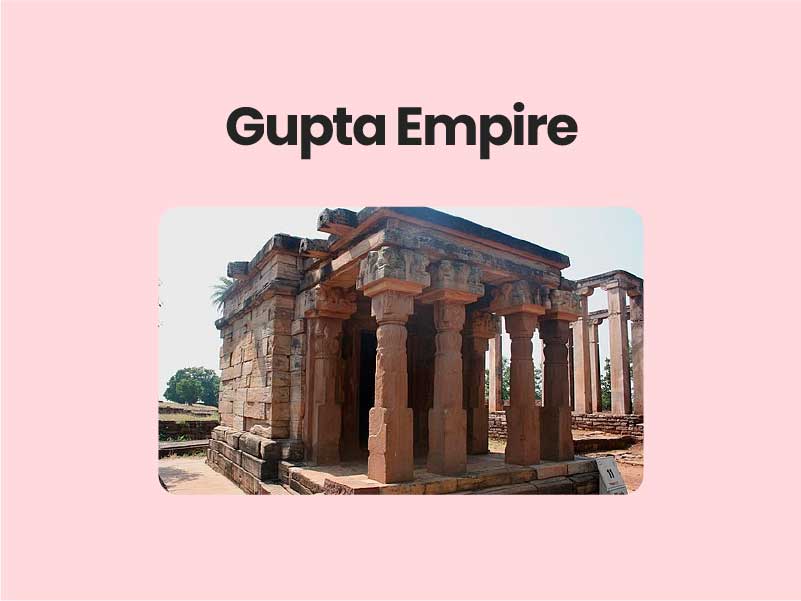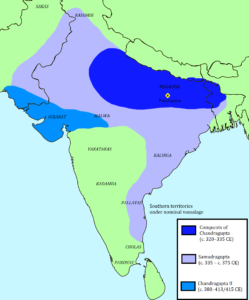Companion@360 → 7 Month programme to sharpen your writing skills → REGISTER NOW

Gupta Empire
Gupta Empire – Contemporary literary works like the Devichandraguptam and the Mudhrakshasam written by Visakadatta provide information regarding the rise of the Guptas
Chinese traveller Fahien, who visited India during the reign of Chandragupta II, has left a valuable account of the social, economic and religious conditions of the Gupta empire.
- Mehrauli Iron Pillar Inscription
- achievements of Chandragupta I.
- Allahabad Pillar inscription.
- the reign of Samudragupta
- It describes his personality and achievements.
- This inscription is engraved on an Asokan pillar.
- written in classical Sanskrit, using the Nagari script. It consists of 33 lines composed by Harisena. It describes the circumstances of Samudragupta’s accession, his military campaigns in North India and the Deccan, his relationship with other contemporary rulers, and his accomplishments as a poet and scholar
Chandragupta I (320 – 330 A.D)
- founder of the Gupta dynasty was Sri Gupta.
- Chandragupta I and he was the first to be called Maharajadhiraja (the great king of kings).
- strengthened his position by a matrimonial alliance with the Licchavis
- married Kumaradevi, a princess of that family. This added to the power and prestige of the Gupta family.
- Mehrauli Iron Pillar inscription mentions his extensive conquests
- Chandragupta I is considered to be the founder of the Gupta era which starts with his accession in A.D. 320.
Samudragupta (330-380 A.D)
- greatest of the rulers of the Gupta dynasty.
- three stages in his military campaign
- Against some rulers of North India
- His famous Dakshinapatha expedition against South Indian rulers
- A second campaign against some other rulers of North India.
- Samudragupta’s policy in South India was different. He did not destroy and annex those kingdoms. Instead, he defeated the rulers but gave them back their kingdoms. He only insisted on them to acknowledge his suzerainty.
- After these military victories, Samudragupta performed the asvamedha sacrifice
- He issued gold and silver coins with the legend ‘restorer of the asvamedha’.
Extant of Samudragupta’s Empire
- Saka and Kushana principalities on the west and northwest were within the sphere of his influence.
- Allahabad Pillar (Nagasena) calls him Kaviraja because of his ability in composing verses.
- image depicting him with Veena is found in the coins issued by him.
- was an ardent follower of Vaishnavism but was tolerant of other creeds
- evinced keen interest in Buddhism and was the patron of the great Buddhist scholar Vasubandhu.
Chandragupta II (380-415 A.D.)
- Samudragupta was succeeded by his son Chandragupta II Vikramaditya
- Fahien’s Visit famous Chinese pilgrim, Fahien visited India during the reign of Chandragupta II.
- nine years stay in India, he spent six years in the Gupta empire
Gupta Administration
- Gupta kings assumed titles like Paramabhattaraka, Maharajadhiraja, Parameswara, Samrat and Chakravartin.
- king was assisted in his administration by a council consisting of a chief minister, a Senapati or commander-in-chief of the army and other important officials
- A high official called Sandivigraha was mentioned in the Gupta inscriptions, most probably minister for foreign affairs
- The king maintained close contact with the provincial administration through a class of officials called Kumaramatyas and Ayuktas.
- Provinces in the Gupta Empire were known as Bhuktis and provincial governors as Uparikas
- They were mostly chosen from among the princes.
- Bhuktis were subdivided into Vaishyas or districts. They were governed by Vishyapatis. Nagara Sreshtis were the officers looking after the city administration. The villages in the district were under the control of Gramikas.
- There was no spy system.
Read Also The Vedic Culture, Jainism And Buddhism
Social Life
- during the Gupta period, the caste system became rigid.
- Brahmins occupied the top ladder of society.
- practice of untouchability had slowly begun during this period. Fahien mentions that Chandalas were segregated from society.
- position of women had also become miserable during the Gupta period.
- prohibited from studying religious texts like the Puranas
- But it was insisted that they should be protected and generously treated by men.
- practice of Swyamvara was given up and the Manusmriti suggested the early marriage for girls.
- Brahmanism reigned supreme during the Gupta period. It had two branches – Vaishnavism and Saivism
- Most of the Gupta kings were Vaishnavaites.
- worship of images and celebration of religious festivals with elaborate rituals made these two religions popular.
- Religious literature like the Puranas was composed during this period.
- progress of Brahmanism led to the neglect of Buddhism and Jainism
- great Jain Council was held at Valabhi during this period and the Jain Canon of the Swetambras was written
Art and Architecture
- Both the Nagara and Dravidian styles of art evolved during this period
- most of the architecture of this period had been lost due to foreign invasions like that of Huns
- The temple at Deogarh near Jhansi and the sculptures in the temple at Garhwas near Allahabad remain important specimen of the Gupta art.
- no influence of Gandhara style
- the beautiful statue of standing Buddha at Mathura reveals a little Greek style.
- Buddha statue unearthed at Saranath was a unique piece of Gupta art. The Bhitari monolithic pillar of Skandagupta is also remarkable.
- Metallurgy had also made a wonderful progress during the Gupta period.
- The gigantic copper statue of Buddha, originally found at Sultanganj now kept at Birmingham museum, was about seven and a half feet height and nearly a ton weight.
- Delhi Iron pillar of the Gupta period is still free from rust though completely exposed to sun and rain for so many centuries
- The paintings of the Gupta period are seen at Bagh caves near Gwalior.
- mural paintings of Ajantha mostly illustrate the life of the Buddha as depicted in the Jataka stories.
- paintings at Sigiriya in Sri Lanka were highly influenced by the Ajantha style.
- Gupta coinage was also remarkable. Samudragupta issued eight types of gold coins.
Literature
- The Sanskrit language became prominent during the Gupta period
- Nagari script had evolved from the Brahmi script.
- Numerous works in classical Sanskrit came to be written in the forms of epic, lyrics, drama and prose. The best of the Sanskrit literature belonged to the Gupta age.
- Samudragupta patronized a number of scholars including Harisena
- court of Chandragupta II was adorned by the celebrated Navratnas.
- Kalidasa remains foremost among them. His master-piece was the Sanskrit drama Shakuntala. It is considered one among the ‘hundred best books of the world’.
- He wrote two other plays – the Malavikagnimitra and Vikramorvasiya. His two well-known epics are Raghuvamsa and Kumarasambhava. Ritusamhara and Meghaduta are his two lyrics.
- Visakadatta was another celebrated author of this period. He was the author of two Sanskrit dramas, Mudrarakshasa and Devichandraguptam
- Sudraka was a renowned poet of this age and his book Mrichchakatika is rich in humour and pathos
- Bharavi’s Kritarjuniya is the story of the conflict between Arjuna and Siva.
- Dandin was the author of Kavyadarsa and Dasakumaracharita
- Another important work of this period was Vasavadatta written by Subhandhu.
- Panchatantra stories were composed by Vishnusarma during the Gupta period.
- The Buddhist author Amarasimha compiled a lexicon called Amarakosa
- The Puranas in their present form were composed during this period. There are eighteen Puranas. The most important among them are the Bhagavatha, Vishnu, Vayu and Matsya Puranas. The Mahabharatha and the Ramayana were given final touches and written in the present form during this period
Science
- Gupta period witnessed a brilliant activity in the sphere of mathematics, astronomy, astrology and medicine.
- Aryabhatta was a great mathematician and astronomer. He wrote the book Aryabhatiya in 499 A.D.
- . It deals with mathematics and astronomy
- Aryabhatta was the first to declare that the earth was spherical in shape and that it rotates on its own axis. However, these views were rejected by later astronomers like Varahamihira and Brahmagupta
- Varahamihira composed Pancha Siddhantika, the five astronomical systems
- His work Brihadsamhita is a great work in Sanskrit literature
- His Brihadjataka is considered to be a standard work on astrology
- field of medicine, Vagbhata lived during this period. He was the last of the great medical trio of ancient India. The other two scholars Charaka and Susruta lived before the Gupta age. Vagbhata was the author Ashtangasamgraha (Summary of the eight branches of medicine)
Read Also Post Mauryan Era


